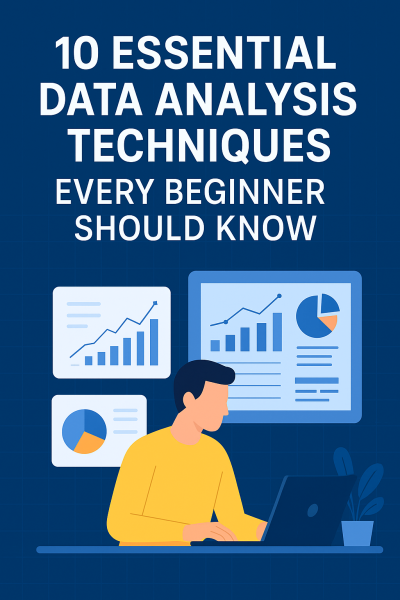In a world where every decision can be guided by data, the ability to analyze and interpret information is one of the most valuable skills you can have. Data analysis is not just for data scientists, it’s a tool anyone can use to make smarter, evidence-based decisions.
In this guide, we’ll walk you through 10 essential data analysis techniques that every beginner should know. These techniques will help you understand data, find patterns, make predictions, and take action all while avoiding the most common beginner mistakes.
Why Data Analysis Matters in Today’s World
From business strategy to personal finance, data is everywhere. Companies rely on it to identify opportunities, prevent losses, and gain a competitive edge. For individuals, data skills can open doors to high-demand careers and better decision-making in everyday life.
Understanding the Data Analysis Process
A complete analysis workflow often follows this process:
- Collect relevant data
- Clean and prepare the data
- Analyze using appropriate techniques
- Visualize the results
- Interpret and make decisions
1. Descriptive Analysis: Understanding the Past
Descriptive analysis helps you answer the question: “What happened?” It focuses on summarizing historical data to identify patterns or trends.
Key Metrics and Summaries
This can include averages, percentages, counts, and visual representations like charts. For example, a store might use descriptive analysis to see monthly sales performance.
When to Use Descriptive Analysis
Use it when you want a clear overview of past performance without making predictions.
2. Diagnostic Analysis: Finding the “Why” Behind the Data
Once you know what happened, diagnostic analysis helps you figure out why it happened.
Root Cause Identification Methods
Techniques include drill-down analysis, data segmentation, and correlation checks.
Practical Examples in Business
If sales dropped last quarter, diagnostic analysis might reveal the cause — fewer repeat customers, supply chain delays, or seasonal demand shifts.
3. Predictive Analysis: Forecasting Future Trends
Predictive analysis uses historical data to make informed predictions about the future.
Common Predictive Models
Regression models, decision trees, and machine learning algorithms are often used.
Data Requirements for Accurate Forecasts
High-quality, well-structured historical data is key for accuracy.
4. Prescriptive Analysis: Recommending the Best Actions
Prescriptive analysis goes beyond prediction, it tells you what you should do next.
Decision-Making Frameworks
This can include optimization models, simulations, or AI-based recommendations.
Real-World Applications
E-commerce platforms recommending products, or logistics companies finding the fastest delivery routes, are real examples.
5. Regression Analysis: Identifying Relationships
Regression analysis helps determine how variables relate to one another.
Types of Regression
Linear Regression shows straight-line relationships
Multiple Regression considers multiple factors at once
Avoiding Common Mistakes
Watch out for overfitting and multicollinearity when building models.
6. Hypothesis Testing: Validating Assumptions
Hypothesis testing helps verify if a claim about your data is statistically valid.
Steps in Hypothesis Testing
Formulate a hypothesis
Select a significance level
Perform a statistical test
Interpret the results
Common Statistical Tests include t-tests, chi-square tests, and ANOVA are frequently used.
7. Data Cleaning and Preparation
Before analysis, raw data must be cleaned to avoid misleading results.
Removing Duplicates and Errors
Ensure there are no repeated entries or obvious mistakes in the dataset.
Formatting and Standardization
Make sure data is consistent for example, dates should follow the same format.
8. Data Visualization Techniques
Visualization makes complex data easier to understand.
Choosing the Right Chart Type
Bar charts, line graphs, scatter plots, and heatmaps each serve different purposes.
Tools for Data Visualization
Excel, Power BI, and Tableau are beginner-friendly tools to start with.
9. Correlation Analysis: Understanding Variable Relationships
Correlation analysis measures how strongly two variables are related.
Pearson vs. Spearman Correlation
Pearson works for linear relationships; Spearman is for ranked data.
Misinterpretations to Avoid
Correlation does not mean causation two trends can move together without one causing the other.
10. Time Series Analysis: Tracking Data Over Time
Time series analysis is used when data points are collected at consistent intervals.
Identifying Patterns and Seasonality
Recognize trends, seasonal effects, and cycles.
Tools for Time Series Analysis
Excel, Python, and R are commonly used for these tasks.
How to Practice and Improve Your Data Analysis Skills
Start with free datasets from Kaggle, Google Dataset Search, or government portals.
Building Your Own Analysis Projects
Pick a topic you care about sports stats, business sales, or survey results — and analyze it from start to finish.
Recommended Articles
Conclusion: Applying These Techniques to Real-World Problems
Mastering these techniques will help you confidently work with data, uncover insights, and make informed decisions. As you grow your skills, you’ll find that data analysis isn’t just a technical task, it’s a powerful way to tell stories, solve problems, and drive success.
Frequently Asked Question:
What are the main types of data analysis for beginners?
How do I choose the right data analysis technique for my project?
Which free tools are best for learning data analysis techniques?
Can I learn data analysis without a statistics background?
What is the difference between predictive and prescriptive analysis?
How important is data cleaning in the analysis process?
What mistakes should beginners avoid in data analysis?

 Data Analysis
Data Analysis
 0 comment
0 comment
 14 Aug, 2025
14 Aug, 2025

SOPHIA OLISE
Data Analyst
Olise Sophia Amarachi is a passionate and purpose-driven data analyst and digital skills advocate based in Nigeria. With a strong foundation in Excel, Power BI, and SQL, she empowers others—especially young people and corps members—through practical training, tech mentorship, and values-based leadership. Sophia’s journey into data analysis began during her NYSC year in Abia State, where she committed herself to learning and growing from scratch. Today, she shares her knowledge through online classes, challenges, and hands-on projects, including dashboards and reports that translate complex data into clear insights.
0 comment